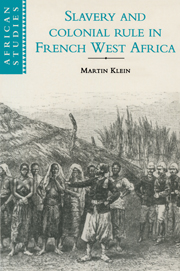Book contents
- Frontmatter
- Contents
- List of illustrations
- List of maps
- List of tables
- Preface
- List of abbreviations
- Glossary
- 1 Slavery in the Western Sudan
- 2 Abolition and retreat. Senegal 1848–1876
- 3 Slavery, slave-trading and social revolution
- 4 Senegal after Brière
- 5 Conquest of the Sudan: Desbordes to Archinard
- 6 Senegal in the 1890s
- 7 The end of the conquest
- 8 The imposition of metropolitan priorities on slavery
- 9 With smoke and mirrors: slavery and the conquest of Guinea
- 10 The Banamba Exodus
- 11 French fears and the limits to an emancipation policy
- 12 Looking for the tracks. How they did it
- 13 After the War: renegotiating social relations
- 14 A question of honor
- Appendixes
- Notes
- Bibliography
- Index
- Titles in the series
Preface
Published online by Cambridge University Press: 07 May 2010
- Frontmatter
- Contents
- List of illustrations
- List of maps
- List of tables
- Preface
- List of abbreviations
- Glossary
- 1 Slavery in the Western Sudan
- 2 Abolition and retreat. Senegal 1848–1876
- 3 Slavery, slave-trading and social revolution
- 4 Senegal after Brière
- 5 Conquest of the Sudan: Desbordes to Archinard
- 6 Senegal in the 1890s
- 7 The end of the conquest
- 8 The imposition of metropolitan priorities on slavery
- 9 With smoke and mirrors: slavery and the conquest of Guinea
- 10 The Banamba Exodus
- 11 French fears and the limits to an emancipation policy
- 12 Looking for the tracks. How they did it
- 13 After the War: renegotiating social relations
- 14 A question of honor
- Appendixes
- Notes
- Bibliography
- Index
- Titles in the series
Summary
Most histories have neither a beginning nor an end. They are part of a seamless web. We cannot say when slavery began in western Africa, though it was certainly long before the period I am studying. And we cannot say when it ended, though there is no place in the three countries being studied where persons are legally owned by other persons. There are still people who are referred to as slaves in various local languages, though very few of them are under the control of another person. Historians impose beginnings and ends in trying to order our understanding of the past. This is a study of slavery in three African countries. I chose to begin with the abolition of slavery by the French National Assembly in 1848, but I am not interested in writing a history of French policy. I am interested in slavery within Africa, which involves understanding how Africans related to each other and to the European intruders in their lands. This means that I had to step back and look at the world in which the French were intruding and which they helped to create. There is no concluding date. The heart of the study deals with the period between 1876, when a maverick prosecutor named Darrigrand tried to enforce the law, and ends about 1921, when the disruptions caused by the return of tirailleurs from World War I ended. But the struggle was not over, and in some ways is not over yet. In each generation, the terms of the struggle change, but the fact of struggle remains.
- Type
- Chapter
- Information
- Slavery and Colonial Rule in French West Africa , pp. xiii - xviPublisher: Cambridge University PressPrint publication year: 1998

